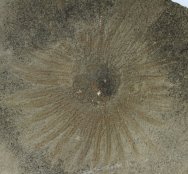Lepidasterella
montanensis
Phylum
Echinodermata, Subphylum Asterozoa, Class Stelleroidea,
Order Spinulosida, Family Heliathasteridae
Geological
Time: Mississippian (~320 m.y.a.)
Size: 105
mm by 95 mm across
Fossil
Site: Bear Gulch Limestone, Heath Shale Formation, Fergus County,
Montana
|  Description:
The Bear Gulch Limestone is a deposit of some 70 square km in
extent and 30 m in depth that has been a source of one of the
most diverse assemblages of fossil fish with some 110 species
having been described over the past 30 years. Most were new to
science, and provided a unique view of the marine environment
of Mississippian times. Fine preservation of both fish and invertebrates
is a hallmark of these deposits, presumably due to an anoxic
depositional environment. This specimen is a fine part/counterpart
example of a many-armed starfish called Lepidasterella. At the
time of its discovery some 25 years ago it was the only known
many-armed starfish known from the time interval ranging from
the Upper Devonian to the Lower Jurassic. The closest living
relatives are the Sun Stars of the Family Solasteridae which
are known as active and voracious predators. Sea Stars are one
of the less commonly seen Paleozoic echinoderms, and thus poorly
documented from the western United States, making this pair quite
unique. Since Asterozoans typically begin to disarticulate soon
after death, this one must have been buried quickly to be in
such a fine state of preservation. Description:
The Bear Gulch Limestone is a deposit of some 70 square km in
extent and 30 m in depth that has been a source of one of the
most diverse assemblages of fossil fish with some 110 species
having been described over the past 30 years. Most were new to
science, and provided a unique view of the marine environment
of Mississippian times. Fine preservation of both fish and invertebrates
is a hallmark of these deposits, presumably due to an anoxic
depositional environment. This specimen is a fine part/counterpart
example of a many-armed starfish called Lepidasterella. At the
time of its discovery some 25 years ago it was the only known
many-armed starfish known from the time interval ranging from
the Upper Devonian to the Lower Jurassic. The closest living
relatives are the Sun Stars of the Family Solasteridae which
are known as active and voracious predators. Sea Stars are one
of the less commonly seen Paleozoic echinoderms, and thus poorly
documented from the western United States, making this pair quite
unique. Since Asterozoans typically begin to disarticulate soon
after death, this one must have been buried quickly to be in
such a fine state of preservation.
Reference:
Journal of Paleontology May 1984 v. 58 no. 3 p. 843-851 |
|








